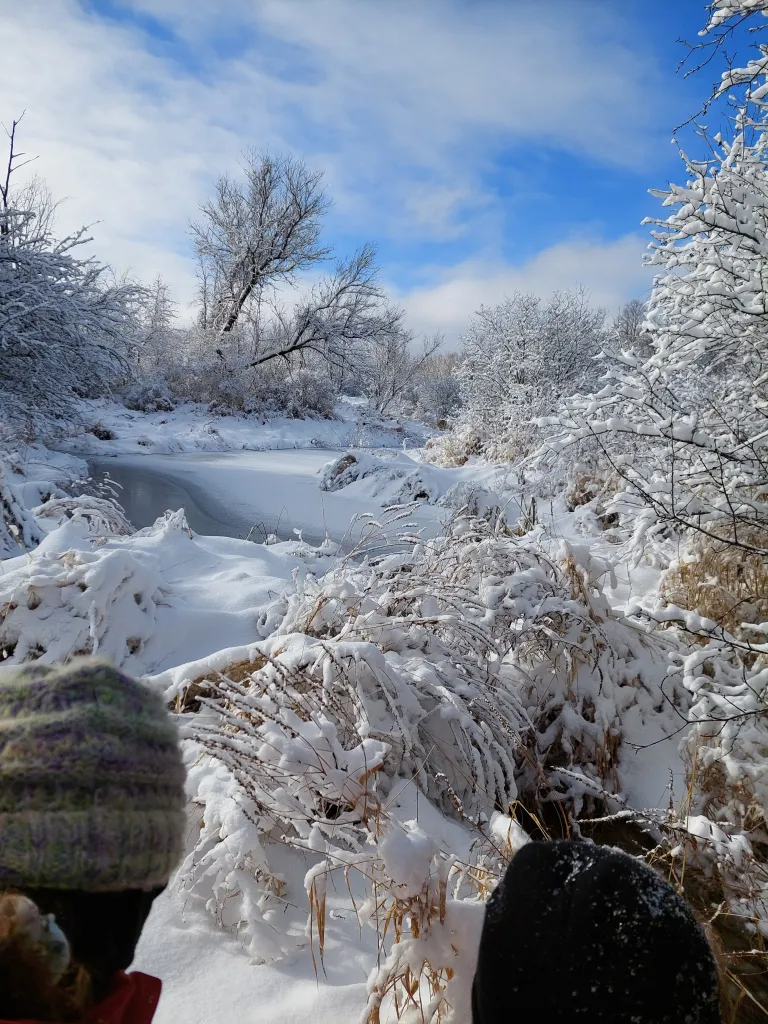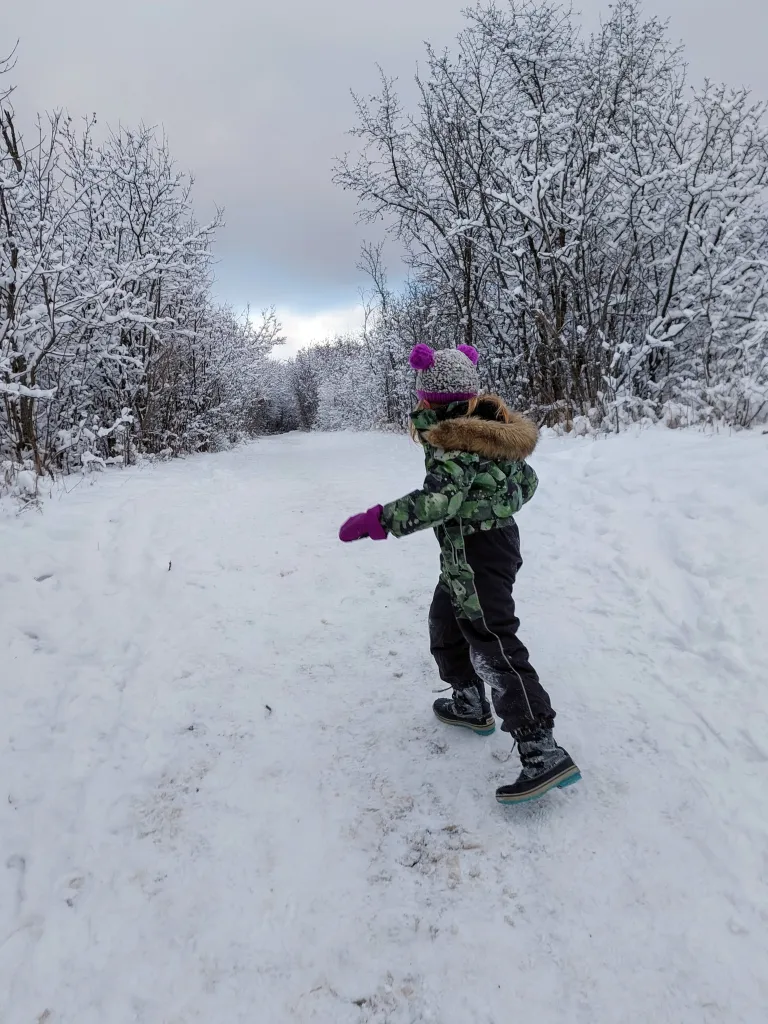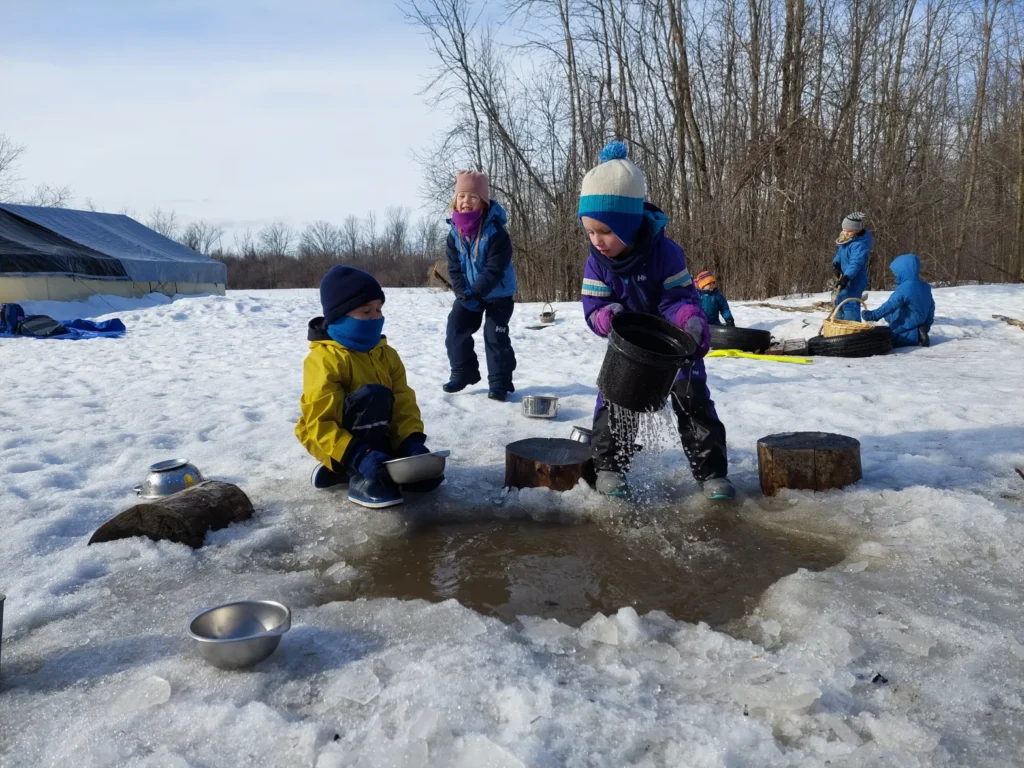A Primer for The Grown-Ups
Encouraging a child to go outside in all weather builds resilience, but more importantly it saves them from spending their life merely tolerating the ‘bad’ days in favour of a handful of ‘good’ ones – a life of endless expectations and conditions where happiness hinges on sunshine.”
Nicolette Sowder

By the time a child strides into the snowy meadow to start their winter day at Out to Play, snowpants swishing, boots stomping, cheeks rosy-ing, they may already have had quite a morning.
Maybe a sibling made a comment that they were happy to stay indoors that morning. Maybe the weather reporter on the radio called for “bad weather.” Or the traffic report claimed that the “roads were terrible!” It might be only 9am, but the little one striding in has quite possibly heard messages that today’s winter weather is unsafe and uncomfortable.
Certainly, the child’s day has already included some unwelcome seasonal necessities: maybe they’re wearing base layers that feel a bit tight or a bit scratchy or a bit short or a bit long. Perhaps they put up some gentle resistance, only to be told by the grown-up who cares very much about them that it is important to be dressed properly for the day. This message might have been repeated over the course of the morning—
“But those socks don’t have unicorns!”
“You need the wool ones or your feet will get cold!”
“But those snowpants make me run slower!”
“I hear you and today is cold. You need them to stay warm!”
Even the most well-meaning adult can pass on fear of the cold to their child in the process of getting ready for a day. And it makes sense that on a wintery morning a child might arrive having already experienced a few stuck moments, and carrying some cold trepidation along with them.

All of us who choose outdoor learning and play are looking to bolster children’s confidence, competence, and agency. We know children need to be dressed thoughtfully and warmly. We understand different fabrics that hold the warmth, and wick moisture away. We know that children need to be kept active and engaged to stay warm as they play. We are informed, qualified and ready for all the winter possibilities.
Though we trust in play and the land, all of us, whether experienced winter educators or new winter friends, know that the cold can be dangerous, unless we’re dressed well. So it makes sense that we are sometimes worried about the temperatures. And it’s inevitable that, despite our best efforts, we sometimes pass that concern on to children.
There are some children that love winter, in all it’s sparkly cold moments, no matter what. But many children need their confidence in winter encouraged. What we have learned at Out to Play is we need to foster confidence, competence and a genuine love for winter in ourselves, in order to authentically convey the cheerful “YOU’VE GOT THIS!” message to children that they so need. And truth? It’s not always easy to foster that love for winter in ourselves.
Some people find joy in moving their bodies in big ways in the winter. They ski, they skate, they dig, they build, they run up sledding hills and laugh as the wind makes their cheeks and teeth hurt. There is something in the momentum of activity, of companionship, of sinking deeply into something, that allows some people to transcend their own physical and emotional discomfort.
But what if you’re not someone with a pre-existing joyful relationship with sporting in the cold? Fortunately, we have seen that there are intentional ways that we can build a positive relationship with the winter. One way is by deciding to be mindful about noticing the small but amazing things around us all the time, even when the world is frozen.
Awe is a term that has gained attention recently in the popular and scientific media as a specific emotion that we can recognize, cultivate and derive personal and social benefits from. Researchers have come up ways to define awe, to quantify the moments of awe that someone experiences, and to correlate that frequency with an individual’s reported overall happiness.
So what is awe, and why do we care about it in the context of building a relationship with winter? According to Dacher Keltner, a scientist at the Greater Good Science Center at the University of California, Berkley:
“Awe is the feeling of being in the presence of something vast that transcends your understanding of the world.”
The feeling of awe can make us feel simultaneously very small and also very connected to something bigger. There are physiological responses to awe that can be measured: a decrease in inflammation markers, an increase in oxytocin. And there are cognitive and emotional responses that show shifts in people’s compassion and critical thinking skills after experiencing a moment of awe. Overall, feelings of awe are associated with an increase in happiness: according to researchers, the average person has a discrete experience of awe two times per week, while the average “happy” individual has a moment of awe every day.

Experiencing awe means allowing a moment outside of yourself to emotionally affect you. That can feel like a difficult barrier, especially in the cold. “First you’re asking me to go outside in the winter, and now you’re asking me to be emotionally vulnerable while I’m doing it?!”
Well, yes. Or at least, I’m going to suggest that you trick yourself into letting down your emotional guard to see if an experience of awe will follow. Something researchers have noticed about our willingness to experience awe is that it is self-fulfilling: when you cultivate an eye or a mind that is open to noticing awe, you will perceive it in more places.
Some people plan and execute intentional fifteen minute “Awe Walks,” where they set out to notice unexpected and beautiful things and to see how it makes them feel. However, if that’s not within your scheduling or emotional purview (totally reasonable, by the way!), you can absolutely start small.
Keltner suggests seeking out patterns in nature—something you can easily fit into your everyday winter motions. These patterns are everywhere, and researchers have found that noticing them in the environment triggers our feeling of vastness and smallness and collectiveness and introspection—awe!—even when we’re not expecting it. Remember this the next time you’re scraping off your car windows, or watching breath condense on a bus window, or looking down at water freezing at the outdoor rink, or watching snow settle into cracks in the sidewalk. Take just a brief moment to allow your eyes and mind to seek out a pattern. You might be able to trick yourself into experiencing awe!


And when you do experience awe, allow yourself to stay in that moment. Happiness researchers say that there is a muscle memory to emotions, and being aware of how your body feels when its experiencing awe can help you access that feeling more easily.
I’ve learned that developing my own joyful relationship with winter means reassuring myself that I can experience joy and awe, while also noticing that it’s cold. Except under obvious emergency conditions, feeling cold doesn’t have to be the one variable that means everything else has to change in my environment. There can be awe, even joy, when my toes are cold.
Dacher Keltner says people who are open to experiencing awe “are more open to new ideas. To what is unknown. To what language can’t describe.”
And just like we can pass concern and trepidation along to our little ones, isn’t it wonderful that we can also pass along joy and awe?
Learning on the land means feeling a sense of belonging, openness and connection. We want that experience for children all year round—not just when it’s warm out. We know they’re already hearing messages of concern about the weather. When we model wonder and awe at the world around us, we share a lightness, a curiosity and a feeling of belonging.
Yes, it feels daunting and vulnerable to decide to love winter on a chilly day. And yes, the awe is there and you will be able to find it. There will be the same number of cold days this winter whether you find joy in them or not. So here’s a vote for joy. Here’s to stepping outside together in search of awe.
Greater Good Science Center, University of California Berkley. https://ggsc.berkeley.edu/
Morgan, Eleanor. (2022, September 23). Oh wow! How getting more awe can improve your life – and even make you a nicer person. The Guardian.

